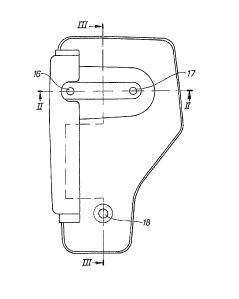Note: Descriptions are shown in the official language in which they were submitted.
* ~ iL L~
The present invention relates to a silencer for small
engines in portable engine-driven tools, e.y. clearing saws.
When using engines in the open air there is a ris~ of
igniting inflammable material close to the gas outlet of the
engine, if the exhaust gases are permitted to contain glowing
particles which might cause fire. In order to reduce the fire
risk stipulations have been issued stating the requirements for
a~proval of such engines for use in woods and fields. Thus, a
silencer should contain a spark trap or the like and have an
arrangement for lowering the gas temperature. The simplest form
of a spark trap is a net in a passage opening between different
chambers of the silencer while, on the other hand, the
arrangement for a temperature reduc~ion can be much more
complicated. Such a complicated arran~Jement is known, for
instance, from the German publication DE-OS 29 29 965.
By the present invention an arrangement of silencer is
presented where, by means of an ejector function, the e~haust
gases are ejected from a silencer chamber through a gap and mixed
up with cooling air from the engine to a lower temperature.
Besides the gap mentioned a guide shield is used which, on one
hand, catches the cooling air and on the other hand forms an
outlet for the gas mixture at a lower temperature.
In a broad aspect, the invention comprises a silencer for
an internal combustion engine of a portable engine-driven tool,
the silencer being divided in two chambers formed by a pair of
metallic shells, the metallic shells forming a joint defined by
a pair of flanges in overlapping relationship, a first one of the
flanges being turned inwards and a second one of the flanges
being turned outwards to define a gap extending along at least
a portion of the periphery of the silencer, the first flange
including recesses therein to establish a fluid communication
between the chamber of the silencer adjoining the first flange
and the environment.
~ n embodiment of the invention is described in the following
with reference to the accompanying dxawings, which show in:
Fig. 1 a vertical projection of the silencer according
to the invention;
- la -
Fig. 2 a horizontal sectlon of the silencer at the line
II - II in Fig. 1;
Fig. 3 a side projection of the silencer with cross
section at III - III in Fig. 1;
Fig. 4 the location of the silencer ln a chain saw with
a cooling fan and a way for cooling air.
Fig. 1 showY a complete silencer in a preferred embodiment,
suitable to be used in a chain saw. The silencer has two
chambers 10,11 which are principally located in a pair of metal
shells 12 and 13, respectively, put together into a unit.
Between the chambers there is a partition wall 14 through which
the chambers communicate via a passage opening 15. The silencer
is mounted by means of three through screws in the holes 16, 17,
18 onto an engine body 19 (Flg. 4). The exhaust gases then enter
into the ~ 7
7~
chamber 10 through a gate 20 between the two upper holes 16 17. The metal
shells are kept together by the screws which provide when being tightened a
compact connection between the silencer and the exhaust gate of the engine.
The joint between the metal shells has a special shaping according to
Fig. ~. On the outer edge of tl e sllell 12 a flar ge 21 ha~ becn cElrried out
which surrounds the whole shell. The flange overlaps the lower edge of the
shell 14 providing a flange 22 turned inwards. In this flange there are some
recesses 23 made along a long side of the shell 13. Through these recesses
chamber 11 is connected to the environment so that the exhaust gases
thereby can leave the chamber. Thanks to parallelism between the
flanges 21, 22 the gas is guided a way which leads along the outside of the
shell 13 ~along the outlet arrow 24).
The indicated way along the arrow 24 has also been created by means o~
a guide plate 25 located outside the corner of the shell 13 and forming in that
way a channel 26 with limit surfaces in the guide plate and the outside oF the
shell. As appears in Fig. 4 the engine has a cooling fan 27 which runs an air
current from an inlet opening 2~ tllrougll an engine room 29, limited by a
casing 3û to an outlet opetling 31 close to tt e silencer. Prior to the outlet
through the opening the air passes the silencer and a part of the air current
takes its way through the channel 26 (see arrow 32 Fig. 2). The air through
the channel proYides an ejecting function on the exhaust outlet along the
arrow 24 and decreases the resistance in the exhaust channel. Thanks to the
bending of the channel round the corner of the silencer a turbulence is
created in it which acts for a good mixture of gas and air.
The spark trap mentioned in the introduction consists in the example
described of a wire net 33 in the passage opening 15. Thanks to the net the
glowing particles called sparks will remain in the chamber 10. Instead of the
recesses 23 there will probably also be a possibility o~ carrying out inward
bends in the flange 22 through which the exhaust gases may escape.
